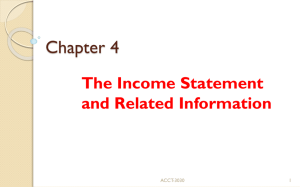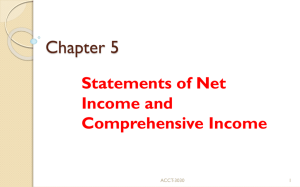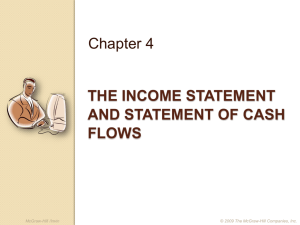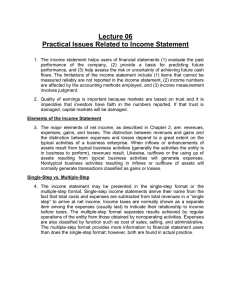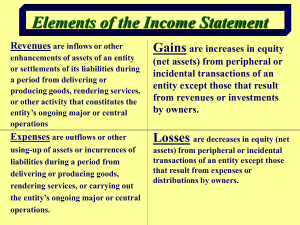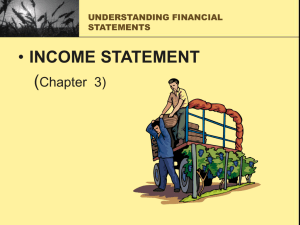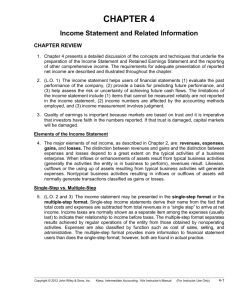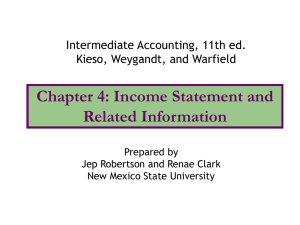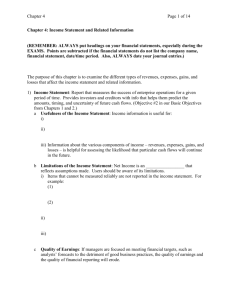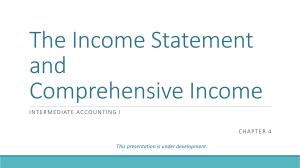Chapter 5
advertisement
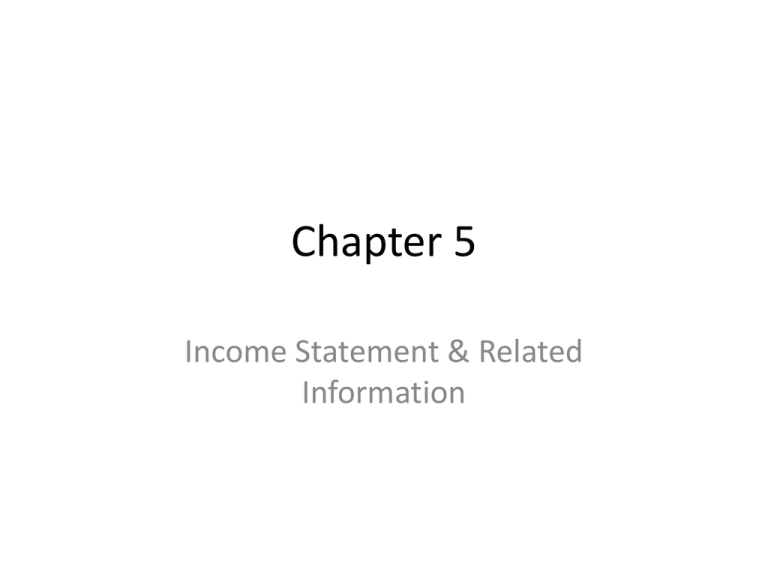
Chapter 5 Income Statement & Related Information Income Statement • Revenues: inflows from major operations • Expenses: outflows from major operations • Gains & Losses: changes in equity from peripheral activities • Non-recurring items • Net income: bottom line all operating activities recorded on the income statement • Comprehensive income: Changes in equity from all non-owner sources (note: usually not reported on the income statement Income Statement Usefulness Evaluate past performance. Predicting future performance. Help assess the risk or uncertainty of achieving future cash flows. Income Statement Limitations Companies omit items that cannot be measured reliably. Income is affected by the accounting methods employed. Income measurement involves judgment. Earnings Quality • Companies have incentives to manage income to meet or beat Wall Street expectations, so that the market price of stock increases and the value of stock options increase. • Quality of earnings is reduced if earnings management results in information that is less useful for predicting future earnings and cash flows. Revenue • Revenues – Inflows or other enhancements of assets or settlements of its liabilities that constitute the entity’s ongoing major or central operations. Sales Fee Revenue (services, etc.) Interest Revenue Dividend Revenue Rent Revenue Expenses • Outflows or other using-up of assets or incurrences of liabilities that constitute the entity’s ongoing major or central operations. Expenses by Category • Cost of goods sold (manufacturing, retail) • Cost of sales (services or services included) • Operating expenses (selling, general & administrative, research & development, other) • Interest income & expenses • Provision for tax Gains & Losses •Gains – Increases in equity (net assets) from peripheral or incidental transactions. •Losses - Decreases in equity (net assets) from peripheral or incidental transactions. • Gains and losses can result from sale of investments or plant assets, settlement of liabilities, write-offs of assets. Non-recurring Items • Extraordinary items • Discontinued operations • Accounting changes Change in accounting principle Change in accounting estimate Correction of an error Single Step Income Statement Income Statement (in thousands) Revenues: Sales Interest revenue Total revenue #### 17,000 #### Expenses: Cost of goods sold 149,000 Advertising expense 10,000 Depreciation expense 43,000 Interest expense 21,000 Income tax expense 24,000 Total expenses #### Net income Earnings per share #### $ 0.75 Multiple Step Income Statement Separates operating transactions from non-operating transactions. Matches costs and expenses with related revenues. Highlights certain intermediate components of income that analysts use. Multiple Step Income Statement Income Statement (in thousands) Sales Cost of goods sold Gross profit #### 149,000 136,000 Operating expenses: Advertising expense 10,000 Depreciation expense 43,000 Total operating expense53,000 Income from operations 83,000 Other revenue (expense): Interest revenue Interest expense Total other Income before taxes Income tax expense 17,000 (21,000) (4,000) 79,000 24,000 Net income Earnings per share #### $ 0.75 Non-recurring & Other Irregular Items • Companies are required to report irregular items in the financial statements so users can determine the long-run earning power of the company. (Irregular items for 600 companies, 1 Year.) Discontinued Operations • Discontinued Operations occur when, – (a) company eliminates the results of operations and cash flows of a component. (b)there is no significant continuing involvement in that component. • Amount reported “net of tax” (intra-period tax allocation). Extraordinary Items • Extraordinary items are nonrecurring material items that differ significantly from a company’s typical business activities. With SFAS #145-relatively rare. • Extraordinary Item must be both of an Unusual nature and Occur infrequently • Company must consider the environment in which it operates. • Amount reported “net of tax.” Unusual Gains & Losses • Material items that are unusual or infrequent, but not both, should be reported in a separate section just above “Income from continuing operations before income taxes.” These are not non-recurring items. • Examples can include: Write-downs of inventories Foreign exchange transaction gains and losses • The Board prohibits net-of-tax treatment for these items. Changes in Accounting Principle Retrospective adjustment Cumulative effect adjustment to beginning retained earnings Approach preserves comparability Examples include: change from FIFO to average cost change from the percentage-of-completion to the completed-contract method Changes in Estimate Accounted for in the period of change and future periods Not handled retrospectively Not considered errors or extraordinary items Examples include: Useful lives and salvage values of depreciable assets Allowance for uncollectible receivables Inventory obsolescence Correction of an Error Result from: mathematical mistakes mistakes in application of accounting principles oversight or misuse of facts Corrections treated as prior period adjustments Adjustment to the beginning balance of retained earnings Tax Allocation Tax Allocation Result from: mathematical mistakes mistakes in application of accounting principles oversight or misuse of facts Corrections treated as prior period adjustments Adjustment to the beginning balance of retained earnings Tax affect is reported within the line item. Inter-period Tax Allocation is the timing difference between GAAP and tax accounting; for example, most companies use straight-line depreciation for financial reporting and accelerated for tax purposes Earnings Per Share (EPS) • Calculation: – Net income - Preferred dividends Weighted average number of shares outstanding An important business indicator. Measures the dollars earned by each share of common stock. Must be disclosed on the income statement. Changes in Retained Earnings Increases: Net income Change in accounting principle Error corrections Decreases: Net loss Dividends Change in accounting principles Error corrections All-Inclusive Income • Net income is considered “modified” allinclusive income • All-inclusive is Comprehensive Income • Some companies report comprehensive income as part of the income statement • For most companies, comprehensive income has to be calculated. Other Comprehensive Income Gains & losses not reported on the income statement (also called “dirty surplus): Unrealized gains and losses on availablefor-sale securities. Translation gains and losses on foreign currency. Pension & derivatives gains & losses Other Comprehensive Income • Usually reported at part of the statement of stockholders’ equity. Comprehensive Income • Balance Sheet presentation (part of stockholders’ equity): Earnings Measures • • • • • • • Gross profit Operating income Income before tax Earnings before income & taxes (EBIT) Income from continuing operations Net income Comprehensive income
